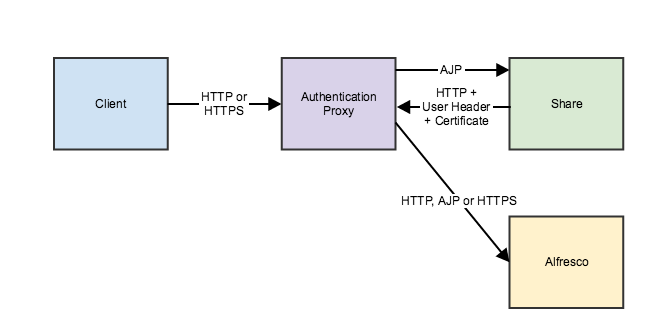What is external authentication?
The external authentication subsystem can be used to integrate SkyVault with any external authentication system. External authentication is set with the authentication.chain parameter in your SkyVault-global.properties file to use the external authentication subsystem.
The external authentication system can be integrated with your application server in such a way that the identity of the logged-in user is passed to servlets by using the HttpServletRequest.getRemoteUser() method. As this is the standard way for application servers to propagate user identities to servlets, it should be compatible with a number of SSO solutions, including Central Authentication Service (CAS).
Here are two scenarios where external authentication is configured with SkyVault and Share. In both scenarios, an HTTP or HTTPS request is sent to an authentication proxy. If authentication is OK, the proxy passes the request to Share using the AJP protocol.
external.authentication.proxyUserName=SkyVault trusts the header (defined by external.authentication.proxyHeader) sent by Share. This scenario is typically used if you want to prohibit direct access to SkyVault and enforce using the proxy, for example, by using firewall rules to the proxy.

external.authentication.proxyUserName=alfresco-systemApache uses the certificate to check that the request is coming from Share with the correct user (that is, the value of external.authentication.proxyUserName) and forwards the request to SkyVault. This scenario is typically used to allow direct access to SkyVault, using HTTPS and the originator (the proxy) sends a client certificate when establishing the SSL tunnel.

Default authentication chain and Configuring external authentication provide more information on the parameter and the external authentication subsystem.
- The complexity of authentication moves to an external software layer (a proxy). SkyVault listens to the authenticated user name that it receives using a custom HTTP header, or it reads the CGI REMOTE_USER variable that can be passed using the AJP protocol. Configuring external authentication provides more information on configuring the external authentication subsystem.
- Most of the responsibility for authentication is not controlled by SkyVault, but controlled by the external software layer. Unless there is a problem when the authenticated user name is transmitted to SkyVault, the issue is located in the external software layer. In these cases, work with your proxy vendor or implementer of the authentication proxy to resolve the issue.
How is Single-Sign On (SSO) related to external authentication?
- If you are using Kerberos, you can use either the kerberos authentication subsystem, or the external authentication subsystem with a proxy that handles Kerberos authentication.
- If you are using NTLM, you can use either the SkyVaultNtlm or passthru authentication subsystems, or the external authentication subsystem with a proxy that handles NTLM authentication.
- If you are using CAS, you must use the external authentication subsystem with a proxy that handles CAS authentication.
In summary, external authentication and SSO are not interdependent: you can set up external authentication that is not SSO (for example, using an Apache proxy with a mod_auth_basic setting), and you can set up an SSO system that is not using the external authentication subsystem (for example, using the kerberos authentication subsystem).
See Authentication subsystem types for a listing of the authentication subsystems and the features that they support.
How is Microsoft SharePoint support related to external authentication?
There are some limitations when using Microsoft SharePoint support with the SkyVault external authentication subsystem. External authentication can work well when using a web browser client, but not when using the MS Office client. This is because no authentication information is sent with the file URL, and MS Office does not store authentication information, so starts a new authentication process.
An example of this is when using CAS. CAS authenticates using an HTML form and a web browser that follows an HTTP redirect. The web authentication works correctly, but MS Office authentication will not work because it does not permit completion of the form. This problem is caused by the limited set of authentication protocols that MS Office supports.
- HTTP Basic
- HTTP Digest
- NTLM
- Kerberos
